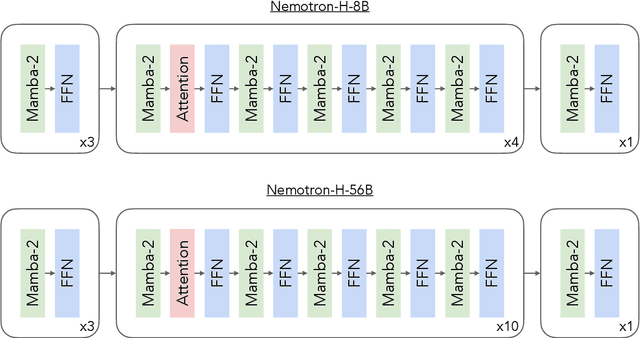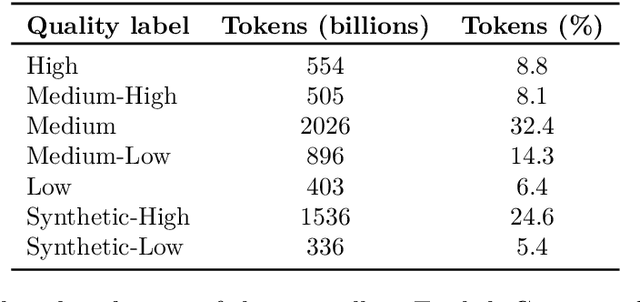Ying Lin
NVIDIA Nemotron 3: Efficient and Open Intelligence
Dec 24, 2025Abstract:We introduce the Nemotron 3 family of models - Nano, Super, and Ultra. These models deliver strong agentic, reasoning, and conversational capabilities. The Nemotron 3 family uses a Mixture-of-Experts hybrid Mamba-Transformer architecture to provide best-in-class throughput and context lengths of up to 1M tokens. Super and Ultra models are trained with NVFP4 and incorporate LatentMoE, a novel approach that improves model quality. The two larger models also include MTP layers for faster text generation. All Nemotron 3 models are post-trained using multi-environment reinforcement learning enabling reasoning, multi-step tool use, and support granular reasoning budget control. Nano, the smallest model, outperforms comparable models in accuracy while remaining extremely cost-efficient for inference. Super is optimized for collaborative agents and high-volume workloads such as IT ticket automation. Ultra, the largest model, provides state-of-the-art accuracy and reasoning performance. Nano is released together with its technical report and this white paper, while Super and Ultra will follow in the coming months. We will openly release the model weights, pre- and post-training software, recipes, and all data for which we hold redistribution rights.
Nemotron 3 Nano: Open, Efficient Mixture-of-Experts Hybrid Mamba-Transformer Model for Agentic Reasoning
Dec 23, 2025Abstract:We present Nemotron 3 Nano 30B-A3B, a Mixture-of-Experts hybrid Mamba-Transformer language model. Nemotron 3 Nano was pretrained on 25 trillion text tokens, including more than 3 trillion new unique tokens over Nemotron 2, followed by supervised fine tuning and large-scale RL on diverse environments. Nemotron 3 Nano achieves better accuracy than our previous generation Nemotron 2 Nano while activating less than half of the parameters per forward pass. It achieves up to 3.3x higher inference throughput than similarly-sized open models like GPT-OSS-20B and Qwen3-30B-A3B-Thinking-2507, while also being more accurate on popular benchmarks. Nemotron 3 Nano demonstrates enhanced agentic, reasoning, and chat abilities and supports context lengths up to 1M tokens. We release both our pretrained Nemotron 3 Nano 30B-A3B Base and post-trained Nemotron 3 Nano 30B-A3B checkpoints on Hugging Face.
Decentralized Optimization with Topology-Independent Communication
Sep 17, 2025Abstract:Distributed optimization requires nodes to coordinate, yet full synchronization scales poorly. When $n$ nodes collaborate through $m$ pairwise regularizers, standard methods demand $\mathcal{O}(m)$ communications per iteration. This paper proposes randomized local coordination: each node independently samples one regularizer uniformly and coordinates only with nodes sharing that term. This exploits partial separability, where each regularizer $G_j$ depends on a subset $S_j \subseteq \{1,\ldots,n\}$ of nodes. For graph-guided regularizers where $|S_j|=2$, expected communication drops to exactly 2 messages per iteration. This method achieves $\tilde{\mathcal{O}}(\varepsilon^{-2})$ iterations for convex objectives and under strong convexity, $\mathcal{O}(\varepsilon^{-1})$ to an $\varepsilon$-solution and $\mathcal{O}(\log(1/\varepsilon))$ to a neighborhood. Replacing the proximal map of the sum $\sum_j G_j$ with the proximal map of a single randomly selected regularizer $G_j$ preserves convergence while eliminating global coordination. Experiments validate both convergence rates and communication efficiency across synthetic and real-world datasets.
NVIDIA Nemotron Nano 2: An Accurate and Efficient Hybrid Mamba-Transformer Reasoning Model
Aug 21, 2025



Abstract:We introduce Nemotron-Nano-9B-v2, a hybrid Mamba-Transformer language model designed to increase throughput for reasoning workloads while achieving state-of-the-art accuracy compared to similarly-sized models. Nemotron-Nano-9B-v2 builds on the Nemotron-H architecture, in which the majority of the self-attention layers in the common Transformer architecture are replaced with Mamba-2 layers, to achieve improved inference speed when generating the long thinking traces needed for reasoning. We create Nemotron-Nano-9B-v2 by first pre-training a 12-billion-parameter model (Nemotron-Nano-12B-v2-Base) on 20 trillion tokens using an FP8 training recipe. After aligning Nemotron-Nano-12B-v2-Base, we employ the Minitron strategy to compress and distill the model with the goal of enabling inference on up to 128k tokens on a single NVIDIA A10G GPU (22GiB of memory, bfloat16 precision). Compared to existing similarly-sized models (e.g., Qwen3-8B), we show that Nemotron-Nano-9B-v2 achieves on-par or better accuracy on reasoning benchmarks while achieving up to 6x higher inference throughput in reasoning settings like 8k input and 16k output tokens. We are releasing Nemotron-Nano-9B-v2, Nemotron-Nano12B-v2-Base, and Nemotron-Nano-9B-v2-Base checkpoints along with the majority of our pre- and post-training datasets on Hugging Face.
Llama-Nemotron: Efficient Reasoning Models
May 02, 2025



Abstract:We introduce the Llama-Nemotron series of models, an open family of heterogeneous reasoning models that deliver exceptional reasoning capabilities, inference efficiency, and an open license for enterprise use. The family comes in three sizes -- Nano (8B), Super (49B), and Ultra (253B) -- and performs competitively with state-of-the-art reasoning models such as DeepSeek-R1 while offering superior inference throughput and memory efficiency. In this report, we discuss the training procedure for these models, which entails using neural architecture search from Llama 3 models for accelerated inference, knowledge distillation, and continued pretraining, followed by a reasoning-focused post-training stage consisting of two main parts: supervised fine-tuning and large scale reinforcement learning. Llama-Nemotron models are the first open-source models to support a dynamic reasoning toggle, allowing users to switch between standard chat and reasoning modes during inference. To further support open research and facilitate model development, we provide the following resources: 1. We release the Llama-Nemotron reasoning models -- LN-Nano, LN-Super, and LN-Ultra -- under the commercially permissive NVIDIA Open Model License Agreement. 2. We release the complete post-training dataset: Llama-Nemotron-Post-Training-Dataset. 3. We also release our training codebases: NeMo, NeMo-Aligner, and Megatron-LM.
NEMOTRON-CROSSTHINK: Scaling Self-Learning beyond Math Reasoning
Apr 15, 2025Abstract:Large Language Models (LLMs) have shown strong reasoning capabilities, particularly when enhanced through Reinforcement Learning (RL). While prior work has successfully applied RL to mathematical reasoning -- where rules and correctness are well-defined -- generalizing these methods to broader reasoning domains remains challenging due to limited data, the lack of verifiable reward structures, and diverse task requirements. In this work, we propose NEMOTRON-CROSSTHINK, a framework that systematically incorporates multi-domain corpora, including both synthetic and real-world question-answer pairs, into RL training to improve generalization across diverse reasoning tasks. NEMOTRON-CROSSTHINK addresses key challenges by (1) incorporating data from varied sources spanning STEM, humanities, social sciences, etc.; (2) applying structured templates (e.g., multiple-choice and open-ended) to control answer-space complexity; (3) filtering for verifiable answers; and (4) optimizing data blending strategies that utilizes data from multiple sources effectively. Our approach enables scalable and verifiable reward modeling beyond mathematics and demonstrates improved accuracies on both math (MATH-500: +30.1%, AMC23:+27.5%) and non-math reasoning benchmarks (MMLU-PRO: +12.8%, GPQA-DIAMOND: +11.3%, AGIEVAL: +15.1%, SUPERGPQA: +3.8%). Moreover, NEMOTRON-CROSSTHINK exhibits significantly improved response efficiency -- using 28% fewer tokens for correct answers -- highlighting more focused and effective reasoning. Through NEMOTRON-CROSSTHINK, we demonstrate that integrating multi-domain, multi-format data in RL leads to more accurate, efficient, and generalizable LLMs.
Nemotron-H: A Family of Accurate and Efficient Hybrid Mamba-Transformer Models
Apr 10, 2025



Abstract:As inference-time scaling becomes critical for enhanced reasoning capabilities, it is increasingly becoming important to build models that are efficient to infer. We introduce Nemotron-H, a family of 8B and 56B/47B hybrid Mamba-Transformer models designed to reduce inference cost for a given accuracy level. To achieve this goal, we replace the majority of self-attention layers in the common Transformer model architecture with Mamba layers that perform constant computation and require constant memory per generated token. We show that Nemotron-H models offer either better or on-par accuracy compared to other similarly-sized state-of-the-art open-sourced Transformer models (e.g., Qwen-2.5-7B/72B and Llama-3.1-8B/70B), while being up to 3$\times$ faster at inference. To further increase inference speed and reduce the memory required at inference time, we created Nemotron-H-47B-Base from the 56B model using a new compression via pruning and distillation technique called MiniPuzzle. Nemotron-H-47B-Base achieves similar accuracy to the 56B model, but is 20% faster to infer. In addition, we introduce an FP8-based training recipe and show that it can achieve on par results with BF16-based training. This recipe is used to train the 56B model. All Nemotron-H models will be released, with support in Hugging Face, NeMo, and Megatron-LM.
Nemotron-CC: Transforming Common Crawl into a Refined Long-Horizon Pretraining Dataset
Dec 03, 2024Abstract:Recent English Common Crawl datasets like FineWeb-Edu and DCLM achieved significant benchmark gains via aggressive model-based filtering, but at the cost of removing 90% of data. This limits their suitability for long token horizon training, such as 15T tokens for Llama 3.1. In this paper, we show how to achieve better trade-offs between accuracy and data quantity by a combination of classifier ensembling, synthetic data rephrasing, and reduced reliance on heuristic filters. When training 8B parameter models for 1T tokens, using a high-quality subset of our data improves MMLU by 5.6 over DCLM, demonstrating the efficacy of our methods for boosting accuracies over a relatively short token horizon. Furthermore, our full 6.3T token dataset matches DCLM on MMLU, but contains four times more unique real tokens than DCLM. This unlocks state-of-the-art training over a long token horizon: an 8B parameter model trained for 15T tokens, of which 7.2T came from our dataset, is better than the Llama 3.1 8B model: +5 on MMLU, +3.1 on ARC-Challenge, and +0.5 on average across ten diverse tasks. The dataset is available at https://data.commoncrawl.org/contrib/Nemotron/Nemotron-CC/index.html
Ranking and Combining Latent Structured Predictive Scores without Labeled Data
Aug 14, 2024



Abstract:Combining multiple predictors obtained from distributed data sources to an accurate meta-learner is promising to achieve enhanced performance in lots of prediction problems. As the accuracy of each predictor is usually unknown, integrating the predictors to achieve better performance is challenging. Conventional ensemble learning methods assess the accuracy of predictors based on extensive labeled data. In practical applications, however, the acquisition of such labeled data can prove to be an arduous task. Furthermore, the predictors under consideration may exhibit high degrees of correlation, particularly when similar data sources or machine learning algorithms were employed during their model training. In response to these challenges, this paper introduces a novel structured unsupervised ensemble learning model (SUEL) to exploit the dependency between a set of predictors with continuous predictive scores, rank the predictors without labeled data and combine them to an ensembled score with weights. Two novel correlation-based decomposition algorithms are further proposed to estimate the SUEL model, constrained quadratic optimization (SUEL.CQO) and matrix-factorization-based (SUEL.MF) approaches. The efficacy of the proposed methods is rigorously assessed through both simulation studies and real-world application of risk genes discovery. The results compellingly demonstrate that the proposed methods can efficiently integrate the dependent predictors to an ensemble model without the need of ground truth data.
FCOM: A Federated Collaborative Online Monitoring Framework via Representation Learning
May 30, 2024Abstract:Online learning has demonstrated notable potential to dynamically allocate limited resources to monitor a large population of processes, effectively balancing the exploitation of processes yielding high rewards, and the exploration of uncertain processes. However, most online learning algorithms were designed under 1) a centralized setting that requires data sharing across processes to obtain an accurate prediction or 2) a homogeneity assumption that estimates a single global model from the decentralized data. To facilitate the online learning of heterogeneous processes from the decentralized data, we propose a federated collaborative online monitoring method, which captures the latent representative models inherent in the population through representation learning and designs a novel federated collaborative UCB algorithm to estimate the representative models from sequentially observed decentralized data. The efficiency of our method is illustrated through theoretical analysis, simulation studies, and decentralized cognitive degradation monitoring in Alzheimer's disease.
 Add to Chrome
Add to Chrome Add to Firefox
Add to Firefox Add to Edge
Add to Edge